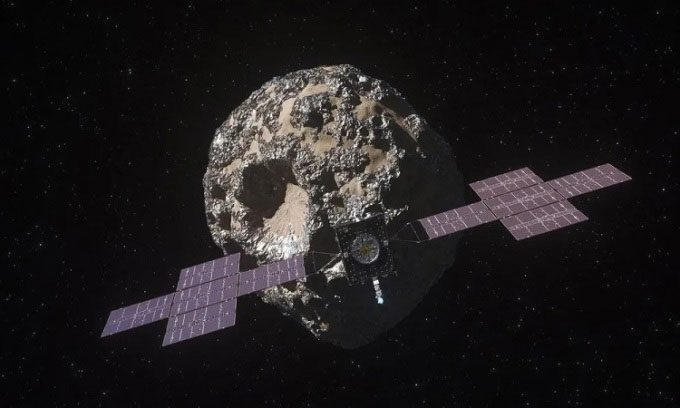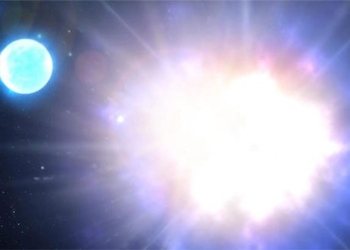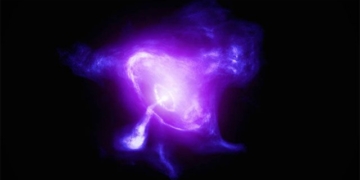The NASA spacecraft is set to fly to a metal-rich asteroid that contains a vast amount of precious metals, including gold, nickel, and iron, estimated to be worth around $10 quintillion, on October 12.
NASA is preparing to launch the Psyche spacecraft on its first mission to study a metal-rich asteroid in detail. The Psyche mission is scheduled to lift off at 9:16 PM on October 12, Hanoi time, from NASA’s Kennedy Space Center in Florida, using SpaceX’s Falcon Heavy rocket. After traveling approximately 3.5 billion kilometers, the spacecraft will arrive at asteroid 16 Psyche, located on the outskirts of the main asteroid belt between Mars and Jupiter, in 2029, according to Space. Once the spacecraft reaches its destination, scientists will study this metal-rich asteroid, which differs from the rocky and icy bodies previously explored, to learn more about the formation processes of rocky planets (Mercury, Venus, Earth, and Mars) in the Solar System.

Simulation of the spacecraft approaching asteroid Psyche. (Photo: NASA)
Discovered in 1852, Psyche is regarded as one of the most intriguing objects in the main asteroid belt, and scientists have only been able to study it from a distance. They believe the asteroid may consist of the exposed core of a protoplanet, a small body that formed when gas and dust collapsed around a star.
A protoplanet could continue to accumulate mass and become a planet. However, Psyche failed to develop into a planet due to collisions with larger bodies during the formation of the Solar System about 4.5 billion years ago, causing the asteroid to lose its outer shell and expose its metal-rich core. Studying this potato-shaped asteroid, which is 279 km wide, will not only shed light on the collisions that occurred in the early Solar System but also provide researchers with a representative of the inaccessible iron core of Earth.
While rocks on the inner planets of the Solar System contain significant amounts of iron oxide, a chemical compound of iron and oxygen atoms, Psyche lacks these compounds. If Psyche includes leftover material from the formation process of rocky planets, its existence could indicate a different planetary formation model separate from the processes that formed Earth. But even if Psyche does not contain the core of a protoplanet, it remains highly interesting to researchers as it belongs to the category of primitive bodies in the Solar System.
One of the most crucial aspects of the Psyche mission is to deliver the spacecraft to the remote asteroid and position it so that scientific instruments can operate. To achieve this, the spacecraft, measuring 4.9 x 2.2 x 2.4 meters, will rely on a solar electric propulsion system that collects sunlight using large solar panels, which is then converted into electricity and electromagnetic fields. The electromagnetic field helps accelerate charged atoms in the xenon propellant. In their ionized, glowing blue gas form, these atoms are expelled into space through the four thrusters of the Psyche spacecraft, providing thrust to the vehicle.
According to NASA, each thruster operates sequentially in the microgravity and frictionless environment of space, propelling the spacecraft forward. However, even with this Hall effect thruster, the spacecraft’s journey toward Jupiter will not be a straight line. Instead, it will need to fly around Mars to gain gravitational assistance in 2026. Psyche is expected to reach its target in August 2029. Following that, the spacecraft will orbit Psyche at an altitude of about 700 km and gradually lower its altitude to study the asteroid’s various features.
During the first orbital cycle (A), which lasts 56 days, the spacecraft will use a magnetometer to search for ancient magnetic fields on Psyche. Simultaneously, the spacecraft’s multispectral camera will assess the surface terrain of Psyche. This equipment will continue to operate as the spacecraft approaches the asteroid, particularly during the next two cycles (B1 and B2), which last 192 days.
In the 100-day long cycle C, Psyche’s remote communication system will be utilized to investigate the asteroid’s gravitational influence, transmit data back to Earth, and receive instructions from the control team via radio waves. This will allow scientists to gain a better understanding of the mass, density, and internal structure of the asteroid. In the also 100-day long cycle D, Psyche will deploy a gamma-ray neutron spectrometer to study the abundant chemical elements on the asteroid’s surface.





















































